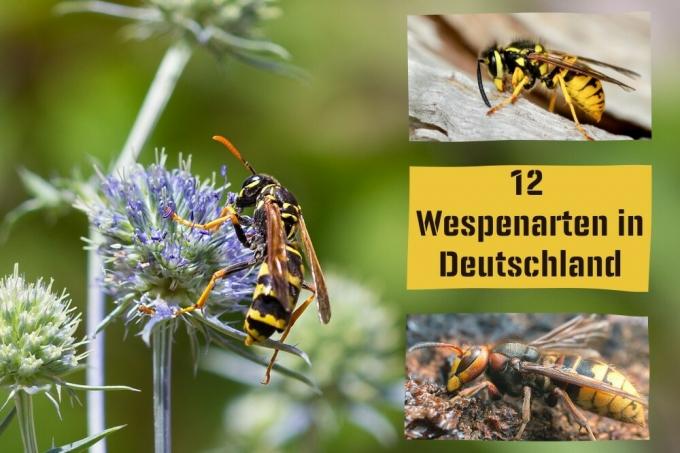
table of contents
- Real wasps (Vespinae)
- Short head wasps (Paravespula)
- Long-headed wasps (Dolichovespula)
- Field wasps (Polistinae)
- Common chimney wasp (Odynerus spinipes)
- frequently asked Questions
Wasps do not have a good reputation, as they are considered to be extremely annoying and dangerous for many people. Most native wasp species are peaceful and by no means lagging behind human food.
In a nutshell
- Wasps are hymenoptera
- 12 different species within the real wasps in Germany
- also other groups, such as field wasps and chimney wasps
- Occurrence: in all regions, mainly in open areas and close to human settlements
- only two species become a nuisance to humans, the common and the German wasp
Real wasps (Vespinae)
The real wasps belong to the family of the social wasps (Vespidae). These are colonizing hymenoptera. Eleven different species of the real wasps are native to Germany and we are introducing them to you here.
Hornet (Vespa crabro)
The hornet is the largest of the wasp species native to Germany. The queen reaches a stately length of up to 35 millimeters, the workers are at least two centimeters long. Hornets are easy to recognize by their characteristic coloring:

- Breast segment drawn in red and black
- Abdomen yellow and black
- Head shield: solid yellow without black markings
the Hornet Queen sets up the nest alone in spring. In this she lays the fertilized eggs from which the workers emerge. In autumn, young queens and males, so-called drones, hatch and eventually swarm out and mate. With the first night frosts, the entire hornet colony dies, including the old queen, only the mated young queens overwinter. Hornets feed on captured insects, tree saps and windfalls.
Note: Hornets are a protected species in Germany and may not be caught or killed. Contrary to all prejudices, hornets are not dangerous: They are peaceful and no more poisonous than wasps or bees.
Short head wasps (Paravespula)
The short-headed wasps also belong to the real wasps, but this genus is characterized by a special one physical feature from: there is none between the lower edge of the eye and the base of the upper jaw Space. The following three wasp species are quite common in Germany.
German wasp (Vespula germanica)
The German wasp, along with the similar common wasp, is one of the most common wasp species in Germany. Typical external features by which Vespula germanica can be identified are:
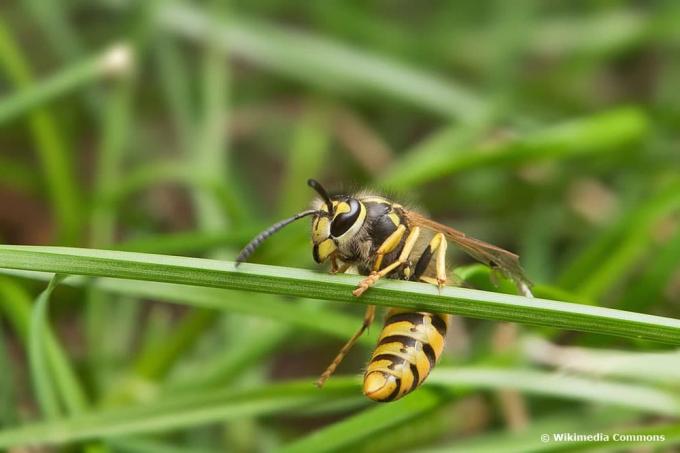
- Queen: up to 20 millimeters in size
- Worker: 13 to 16 millimeters tall
- Drone: 13 to 17 millimeters in size
- wasp-typical black-yellow color
- Distinguishing features: one to three black points on the head shield
The German wasp also builds its nests underground, preferably in mole and mouse tunnels. Sometimes, however, they can also be found in the roof trusses of buildings, because this species of wasp - like so many species - needs rotten wood to build nests.
The German and the Common Wasp look very similar, but you can tell by the color of each other Differentiate nests from one another: German wasps tend to build grayish nests, common wasps lighter ones, beige. A wasp state of this type usually comprises around 3,000 to 4,000 individual animals.
Common wasp (Vespula vulgaris)
The common wasp is one of the most common wasp species in Central Europe. You can recognize them by these features:
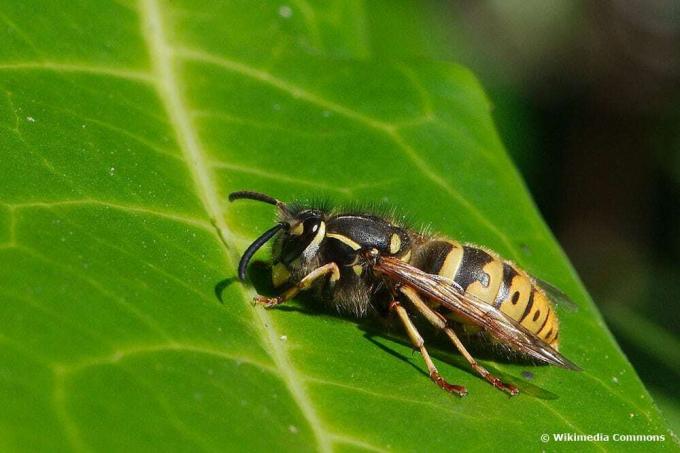
- Length: between 11 and 19 millimeters
- The abdomen has a characteristic black and yellow pattern
- yellow head shield with black, anchor-shaped drawing
- occur between April and October
- Occurrence: widespread and mostly common in large parts of Europe, populated open landscapes, often found in settlement areas
The overwintering young queen starts building nests and laying eggs in spring. Their finely chewed wood, which is mixed with saliva, serves as building material. After the first workers hatch, the queen no longer leaves the nest, but only lays eggs. The resulting insect state is strictly organized according to the division of labor and the workers are either
- with the nest building
- of cell cleaning
- larval feeding
- the defense of the nest
- supplying the queen
- or the pursuit of food
employed. The size of the nest increases rapidly, growing to 3,000 to 4,000 individuals or even more.
Note: The bad reputation of the wasps is due to the nature of the animals in the summer when having a coffee on the terrace or having a barbecue evening. However, this only applies to the two species German wasp and common wasp, because all other wasp species are not interested in human food.
Red wasp (Vespula rufa)
The red wasp is closely related to the common and German wasp, but avoids humans and does not eat human food. The species is considered peaceful.

- Queen: 16 to 20 millimeters tall
- Worker: 10 to 14 millimeters tall
- Drone: 13 to 16 millimeters in size
- Color: wasp-typical black-yellow, but two anterior red abdomen segments
- Diet: umbelliferous nectar and aphid honeydew
- Larvae are fed with fly and mosquito larvae
- underground nests, especially in burrows of mice and moles
- small colonies with 150 to 350 individual animals
Red wasps are usually peaceful even near the nest.
Long-headed wasps (Dolichovespula)
From the short-headed wasps presented here, long-headed wasps are distinguished by the clear space between the lower edge of the eye and the base of the upper jaw. The various wasp species are common in Central Europe and are often found quite frequently. They colonize both open biotopes and human settlements.
False cuckoo wasp (Dolichovespula adulterina)
This type is a so-called social parasite. False cuckoo wasps do not build their own nests, but lay their eggs in the nests of the Saxon wasp. Thus, their occurrence extends to the same regions as that of the host species. No state of its own will be formed.
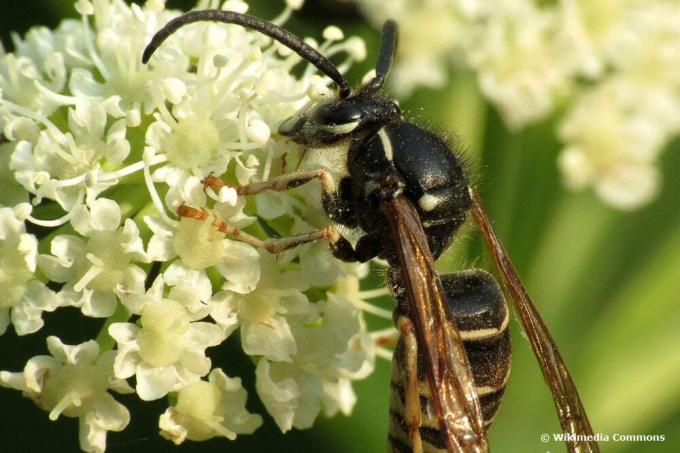
- Length females: 14 to 17 millimeters
- Length of drones: 12 to 15 millimeters
- Coloring is typical of wasp, but very variable
- Flight time between mid-June to the end of August
The false cuckoo wasp occasionally stings people, but it hardly hurts.
Medium wasp / small hornet (Dolichovespula media)
This relatively peaceful species only occasionally occurs aggressively in the nest area.
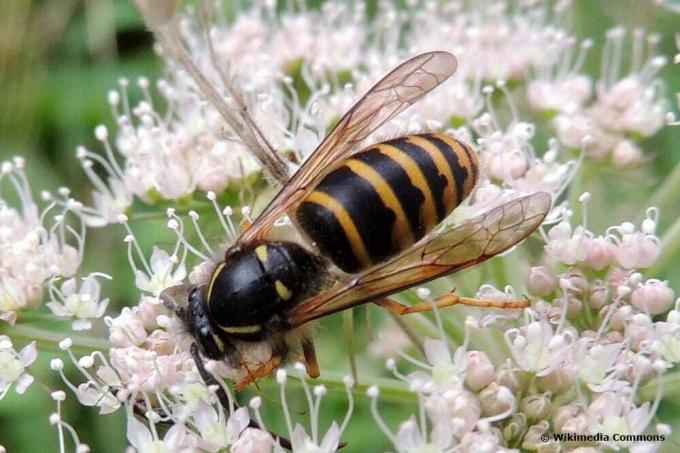
- Queen: 18 to 22 millimeters tall
- Worker: 15 to 19 millimeters tall
- Drone: 15 to 19 millimeters in size
- Coloring: very variable, workers and drones mostly black with only narrow yellow markings, queens can easily be mistaken for a hornet
- Occurrence: mainly in Northern Europe
- Way of life: builds paper nests mainly from poplar wood, mostly in bushes or hedges at heights between one and four meters, colony often dies in late summer / early autumn
Norwegian wasp (Dolichovespula norwegica)
The Norwegian wasp looks very similar to the more common red wasp.
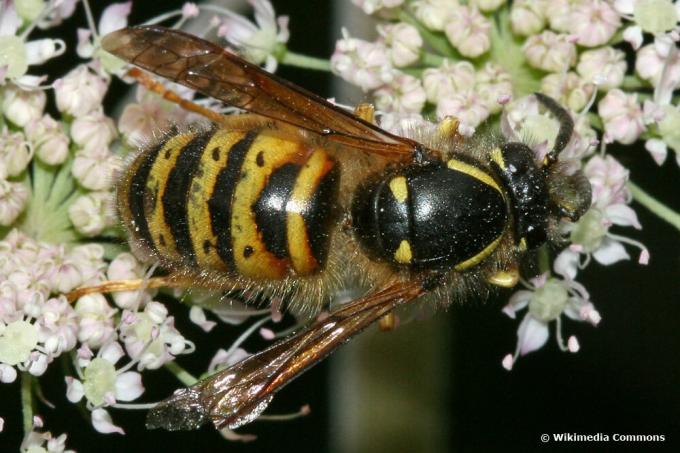
- Queen: 15 to 19 millimeters tall
- Worker: 12 to 15 millimeters tall
- Drone: 14 to 16 millimeters in size
- Color: wasp-typical black-yellow, the two anterior abdominal segments are reddish
- Occurrence: mainly in mountainous, forested regions
- Way of life: builds nests close to the ground in bushes and piles of wood, avoids the proximity of people
As is typical for wasps, the species feeds primarily on honeydew and the nectar of umbellifers, only the larvae need animal protein in the form of prey insects. Mainly mosquitoes and various types of flies are captured for this purpose.
Saxon wasp (Dolichovespula saxonica)
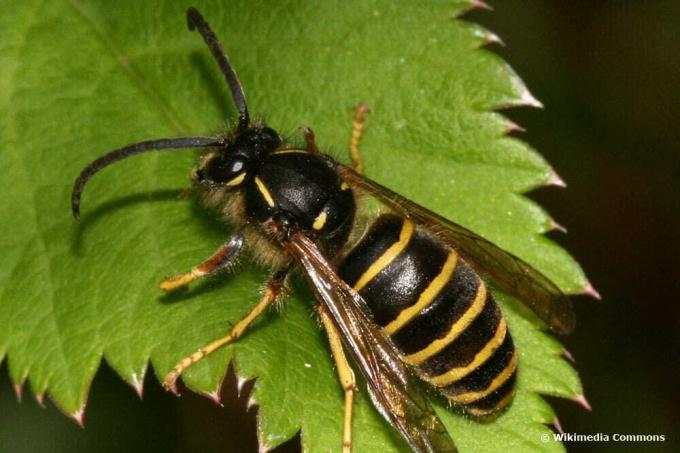
The very common Saxon wasp is only 11 to 18 millimeters long and forms relatively small colonies with up to 300 individuals. The nests are often created in buildings - for example in barns and garden sheds - and are preferably found freely hanging in the roof beams. To build a nest, the workers grate rotten wood with their mouthparts and mix it with salivary gland secretions to form a pulp. The grayish paper nest reaches a diameter of up to 25 millimeters.
This species of wasp feeds mainly on flower nectar, but prey on other insects to nourish its larvae. The species is peaceful even in the nest area, does not become a nuisance and does not eat food. Their appearance is typical of wasp with the narrow "wasp waist" and the black and yellow markings, but very variable between individuals. This mainly applies to the yellow abdomen drawing.
Wood Wasp (Dolichovespula sylvestris)
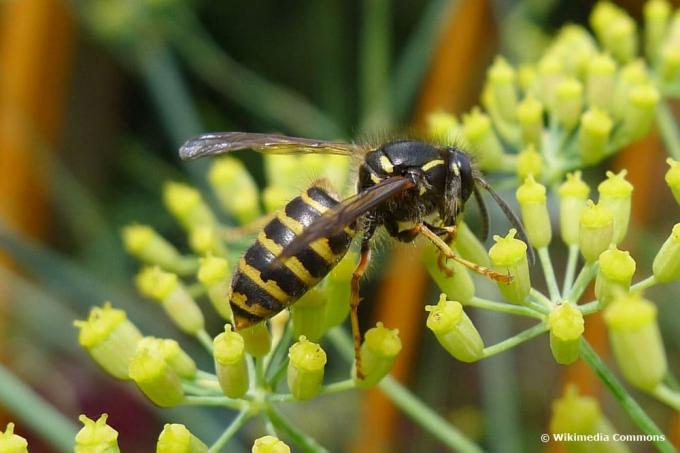
- Queen: 15 to 19 millimeters tall
- Worker: 13 to 15 millimeters tall
- Drone: 14 to 16 millimeters in size
- Color: wasp-typical black-yellow
- Distinguishing features: from other long-headed wasps purely outwardly indistinguishable
- Occurrence: widespread in Europe, mainly open forests, but also open regions and human settlement areas
- Way of life: Nests hanging freely in protected places, preferably in burrows, bushes, buildings, up to 800 individual animals
Forest Cuckoo Wasp (Dolichovespula omissa)
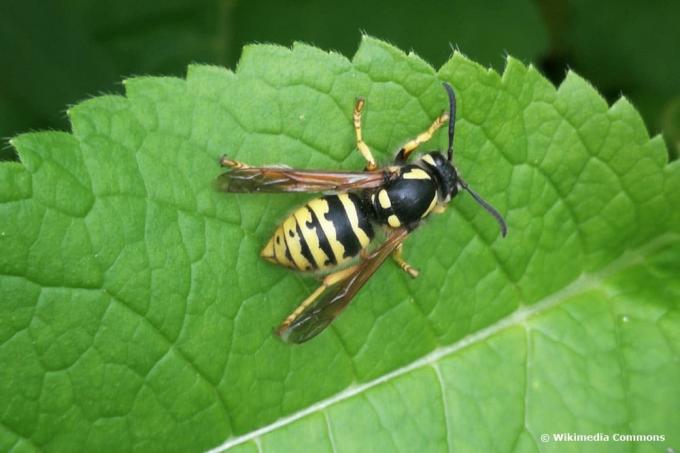
This species is a so-called social parasite that does not build its own nests and does not develop a hierarchically structured people. For its survival, the forest cuckoo wasp depends on the occurrence of the wood wasp, in whose nests it lays its eggs. Forest cuckoo wasps cannot be distinguished from other long-headed wasps by their external characteristics, however, they are often found in larger groups during the summer months Umbelliferous plants.
Field wasps (Polistinae)
Depending on the author, the different species of field wasps are sometimes counted among the real wasps, sometimes not. Mostly, however, they are counted among the so-called paper wasps, which build their nests in a paper-like manner from chewed and salivated wood fibers. The finished paper nest consists of open, exposed honeycombs without a protective cover and is attached to the ground with a handle.
In Germany there are mainly these very similar species of wasp:
- Mountain wasp (Polistes biglumis)
- Mountain Field Wasp Cuckoo Wasp (Polistes atrimandibularis)
- Gallic field wasp / house field wasp (Polistes dominula)
- Heath Field Wasp (Polistes nimpha)
- Petite field wasp (Polistes bischoffi)

The Gallic field wasp, also known as the house field wasp, often settles in human proximity and builds their nests under roof tiles or in sheds, for example.
You can distinguish the field wasp species from other wasp species by these characteristics:
- very thin "wasp waist"
- slim abdomen
- this is also clearly narrowed towards the front
The field wasp into a busy flower visitor. It does not become a nuisance to people and is mostly peaceful, it only attacks in the immediate vicinity of the nest or in the event of an immediate disturbance and can then stab painfully. In the spring, several queens usually found a small colony together, in the course of which a hierarchy with a "female boss" is at the top.
Common chimney wasp (Odynerus spinipes)
In contrast to the other wasp species presented here, the chimney wasp does not form states. Instead, it is a solitary variety that often settles in groups in smaller colonies. These groups can be found particularly frequently in steep clay walls, in clay walls on buildings, in dry stone walls and in special nesting aids in gardens.
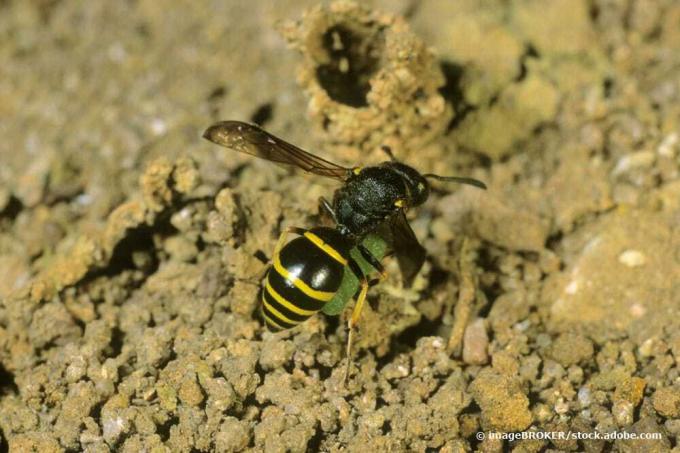
The chimney-shaped brood tubes are characteristic and also give the species its name: the females of the chimney wasp dig diagonally into the substrate. The resulting excavation is moistened with liquid and glued in a ring around the entrance hole, creating the typical nesting entrances.
At the end of the corridor, some chest chambers are created, each of which is covered with an egg and filled with up to 20 weevil larvae for their own offspring.
Chimney wasps occur between May and July. They can be identified by these features:
- Length: between ten and 13 millimeters
- colored almost completely black
- Abdomen only narrowly curled in yellow
- Antennae, club-shaped, thickened
Tip: With a range of vertical, sun-exposed clay surfaces, the chimney wasp can be easily observed in gardens and even on the balcony.
frequently asked Questions
The insects known as "black hornets" are actually wooden bees (Xylocopa violacea). With a length of up to 24 millimeters, these hymenoptera are among the largest European bees. The species is widespread in southern Europe and so far restricted to heat-favored regions in central Europe. However, it is spreading increasingly northwards in the course of global warming. If you want to offer the wooden bee nesting opportunities in the garden, you can do this with vertically attached, sun-exposed dead wood trunks.
Neither gall wasps nor parasitic wasps belong to the real wasps. Gall wasps are legims and usually do not grow larger than four to five millimeters. A common species is the oak gall wasp (Cynips quercusfolii), which lays its eggs in oak leaves. Parasitic wasps are also part of the Legims, but lay their eggs parasitically in the larvae of their host insects. They are often used in biological pest control.
Digger wasps only have the name in common with real wasps. This group of hymenoptera belongs to the stinging voices and is closely related to the bees. A common species in Germany is the common sand wasp (Ammophila sabulosa), which digs its brood tubes vertically in sandy soils and camouflages the entrance with a stone. Adult sand wasps feed on nectar and carry out extensive brood care: they regularly feed their larvae with butterfly larvae.


